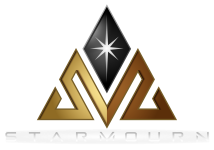Our final Winterflame present: New Player Race Releases!
We’ve been hinting as hard as we dared, but now it’s finally time for the big reveal! This year we’re unveiling two new player races: Belaul and Bushraki!
Both of these races have been highly anticipated, but of course Bushraki are the fan favorite that you have been asking for since LAUNCH! We are so excited for everyone to dive in and learn more about these awesome new additions to the Starmourn player sector.

A hardy race of avian humanoids native to the frozen planet of Paperweight, the Belaul have only recently taken to the stars for the first time, having lived for many millennia in peace and seclusion. While their technologies differ from those of the interstellar community, the Belaul are far from primitive, living in comfort and safety thanks to their technological achievements, such as advanced optics, solar power, and wireless energy transmission.
Though flightless, they have an impressive pair of wide-spanning wings which extend from their shoulder blades, and their bodies are covered with feathers ranging from a stark white to a tawny brown shade. Their three sharp talons on both feet and hands serve as dangerous complements to their curved beaks. Despite a relatively small stature, the Belaul have little fear for the predators of their ecosystems, resting comfortably on their perch at the top of the food chain.
As recently as 212 A.E following the crash of the Li’Gon, the beginning of a terrible Ice Age has overtaken the temperate grasslands and boreal forests of their home. As the climate continued to shift, the Belaul gathered around the greatest belfir trees, creating a network of tribal communities called Nests beneath the boughs of the frost-resistant forests. When lost in the frost for too long, some Belaul become deranged and violent, succumbing to a well-feared disease called ‘tundra madness’ which can only be cured by a potent combination of locally sourced herbs.
Communities within each of the Nests are led by two leaders called Wings who are chosen for strength and wisdom respectively. Intrinsically connected to the natural world, Belaul hold a great reverence for the Sh’than’alu, a pantheon of gods embodied by the animals of the tundra, which represent crucial lessons that every Belaul must understand. Each tribe thrives in isolation, neither contributing significantly to interstellar economies nor relying on them. Their native language is made up of both tonal chirps and gestures, with celebrations and cautionary tales chirped through song around a bonfire.

A troubled people with a violent past, the Bushraki have been shaped by generations of enslavement, experimentation and warfare. Remarkably similar in physiology to Humans, the Bushraki bear little resemblance to other humanoids as they undergo drastic body modification even before birth.
Fueled by rage and bloodlust after generations of torturous experimentation by the Sa’hak-ren Hierarchy until 366 B.E., the genetically modified Bushraki shock troops turned on their oppressors and escaped into the sector, dealing drugs and punishment in equal parts as they pursued righteous retribution. Their brutality caught the attention of the Ishvana, which granted the beings Mindsim technology and promised aid in their quest for revenge, but this alliance was never meant to last. 200 years later, the Bushraki betrayed the Ishvana in the Second Ishvana War, making an enemy of the most brutal force in the sector and resulting in the destruction of their homeworld, Dikamazi.
Despite the steps that Bushraki society has taken towards rehabilitation, they are still kept at arms length by many communities across the sector who are unable to look past the struggles and outbursts of the modern Bushraki, or past their history of cruelty and genocide as unwilling soldiers of their former overlords. They have been slowly reforming their culture with major population centers located in Haven City and New Dikamazi and a focus on improving their status in the sector.
Bushraki have been genetweaked to support drastic body modification that would otherwise prove lethal. Today, Bushraki express their identities in the style and function of their implants, and take enormous pride in the abilities it affords them, whether that’s doing shots of engine-oil or staring into the sun.
